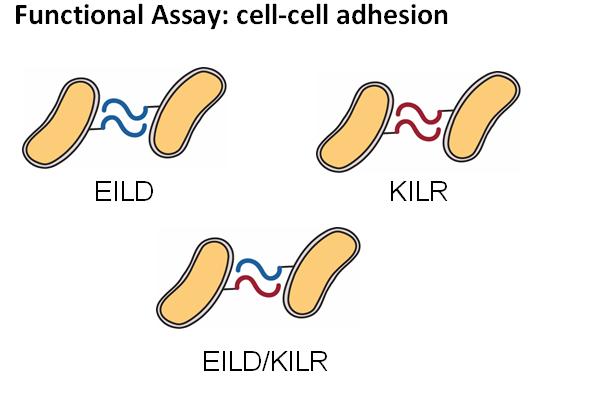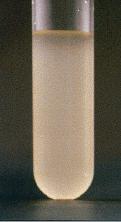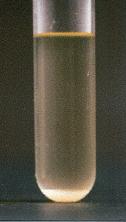Team:Berkeley Wetlab/Passenger: Leucine Zippers
From 2009.igem.org
(→Functional Assay: Cell-Cell Clumping) |
|||
| Line 3: | Line 3: | ||
One potential use of cell surface display is to adhere cells together selectively such that there is structure. However, such a feat is impossible to do in one step. In order to work up to such a goal, the first step of such an endeavor is create a basic system of adhere 2 cells types together. We propse using dimeric leucine zippers to adhere cells to one another. Leucine zippers are short peptides which form alpha helices that compliment each other. Using a GNC4 leucine zipper heterodimers KILR and EILD, we hoped to adhere cells to one another. | One potential use of cell surface display is to adhere cells together selectively such that there is structure. However, such a feat is impossible to do in one step. In order to work up to such a goal, the first step of such an endeavor is create a basic system of adhere 2 cells types together. We propse using dimeric leucine zippers to adhere cells to one another. Leucine zippers are short peptides which form alpha helices that compliment each other. Using a GNC4 leucine zipper heterodimers KILR and EILD, we hoped to adhere cells to one another. | ||
| - | ==Functional Assay: Cell-Cell | + | ==Functional Assay: Cell-Cell Adhesion== |
| + | This assay tests for the functionality of displayed leucine zippers via the leucine zipper's ability to dimerized with each other and, as a result, pull the cells out of solution into a clump. | ||
[[Image:IGem2009_leucine_zipper_cartoon.jpg |500px]] | [[Image:IGem2009_leucine_zipper_cartoon.jpg |500px]] | ||
<left> [[Image:iGem2009Berkeley_Cloudy.jpg |100px]]</left> | <left> [[Image:iGem2009Berkeley_Cloudy.jpg |100px]]</left> | ||
Revision as of 04:32, 21 October 2009
Contents |
Leucine Zippers
One potential use of cell surface display is to adhere cells together selectively such that there is structure. However, such a feat is impossible to do in one step. In order to work up to such a goal, the first step of such an endeavor is create a basic system of adhere 2 cells types together. We propse using dimeric leucine zippers to adhere cells to one another. Leucine zippers are short peptides which form alpha helices that compliment each other. Using a GNC4 leucine zipper heterodimers KILR and EILD, we hoped to adhere cells to one another.
Functional Assay: Cell-Cell Adhesion
This assay tests for the functionality of displayed leucine zippers via the leucine zipper's ability to dimerized with each other and, as a result, pull the cells out of solution into a clump.
 <left>
<left>  </left>
<left>
</left>
<left>  </left>
</left>
 "
"






